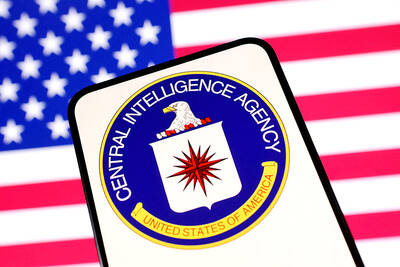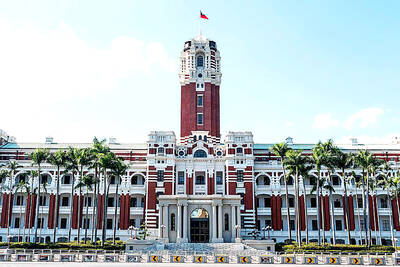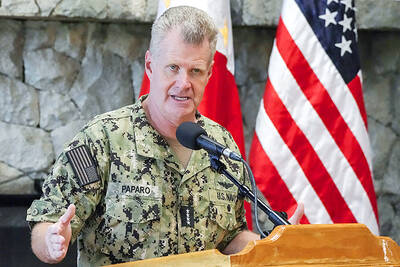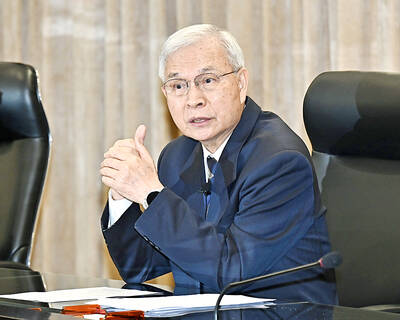JPMorgan Chase & Co was in talks to quintuple its offer to buy Bear Stearns Cos to US$10 per share in an effort to pacify angry Bear Stearns shareholders, the New York Times said yesterday.
JPMorgan's original agreement on March 16 to pay US$2 per share for Bear Stearns was widely considered a fire-sale price for the 85-year-old Wall Street investment bank. Bear Stearns collapsed in a liquidity crisis after suffering large subprime mortgage losses and falling confidence in dealing with the company.
The original agreement had won support of federal regulators, but the US Federal Reserve is now balking at the new price, the newspaper said, citing people involved in the talks.
As a result, the renegotiated merger might be postponed or collapse, it said.
A US$10 per share offer would value Bear Stearns at more than US$1 billion. That price, however, is still less than one-third of where the stock traded on March 14, the last trading day before the original merger was announced.
It is also less than 10 percent of where the stock traded for much of last year.
Representatives of Bear Stearns, JPMorgan and the Fed were not immediately available for comment.
Jamie Dimon, JPMorgan's chief executive, grew convinced the merger was in jeopardy after spending much of the last week taking calls from indignant shareholders, the newspaper said, citing people involved in the talks.
Among these shareholders was the British entrepreneur Joseph Lewis, who spent more than US$1 billion on some 12.1 million Bear Stearns shares, including some as recently as March 13.
Last week, Lewis said he would take whatever action was needed to protect his investment, and may encourage Bear Stearns and third parties to pursue other transactions.
Bear Stearns shares closed on Thursday at US$6.39, reflecting investor expectations that JPMorgan might raise its bid, or another suitor might offer a sweetened price. JPMorgan shares closed at US$45.97.
In an attempt to speed majority shareholder approval, Bear Stearns' board was trying to authorize the sale of 39.5 percent of the firm to JPMorgan, the NYT said.
State law in Delaware, where JPMorgan and Bear Stearns are incorporated, allows a company to sell up to 40 percent without shareholder approval.
A spokeswoman for JPMorgan declined to comment Sunday night, the NYT said.
A Bear Stearns representative could not be reached.
A spokesman for the Federal Reserve would not comment on the central bank's involvement in the negotiations, but denied it had directed the original sale price, the newspaper said.
Citing people involved in the talks, the newspaper said the central bank originally directed JPMorgan to pay no more than US$2 per share to assure that it would not appear that Bear Stearns shareholders were being rescued.
As part of the original transaction, the Fed also extended a US$30 billion credit line to JPMorgan to finance Bear Stearns' most illiquid assets.
JPMorgan was in talks on Sunday night with the Fed to assume the first US$1 billion of losses on Bear Stearns assets before the US$30 billion cushion kicks in, the newspaper said.
The original agreement called for JPMorgan to swap 0.05473 of its shares for each Bear Stearns share.
Some large Bear Stearns shareholders have considered opposing the merger to send the company into bankruptcy, where they might hope to get more than US$2 per share from creditors, the newspaper said.

The CIA has a message for Chinese government officials worried about their place in Chinese President Xi Jinping’s (習近平) government: Come work with us. The agency released two Mandarin-language videos on social media on Thursday inviting disgruntled officials to contact the CIA. The recruitment videos posted on YouTube and X racked up more than 5 million views combined in their first day. The outreach comes as CIA Director John Ratcliffe has vowed to boost the agency’s use of intelligence from human sources and its focus on China, which has recently targeted US officials with its own espionage operations. The videos are “aimed at

STEADFAST FRIEND: The bills encourage increased Taiwan-US engagement and address China’s distortion of UN Resolution 2758 to isolate Taiwan internationally The Presidential Office yesterday thanked the US House of Representatives for unanimously passing two Taiwan-related bills highlighting its solid support for Taiwan’s democracy and global participation, and for deepening bilateral relations. One of the bills, the Taiwan Assurance Implementation Act, requires the US Department of State to periodically review its guidelines for engagement with Taiwan, and report to the US Congress on the guidelines and plans to lift self-imposed limitations on US-Taiwan engagement. The other bill is the Taiwan International Solidarity Act, which clarifies that UN Resolution 2758 does not address the issue of the representation of Taiwan or its people in

US Indo-Pacific Commander Admiral Samuel Paparo on Friday expressed concern over the rate at which China is diversifying its military exercises, the Financial Times (FT) reported on Saturday. “The rates of change on the depth and breadth of their exercises is the one non-linear effect that I’ve seen in the last year that wakes me up at night or keeps me up at night,” Paparo was quoted by FT as saying while attending the annual Sedona Forum at the McCain Institute in Arizona. Paparo also expressed concern over the speed with which China was expanding its military. While the US

SHIFT: Taiwan’s better-than-expected first-quarter GDP and signs of weakness in the US have driven global capital back to emerging markets, the central bank head said The central bank yesterday blamed market speculation for the steep rise in the local currency, and urged exporters and financial institutions to stay calm and stop panic sell-offs to avoid hurting their own profitability. The nation’s top monetary policymaker said that it would step in, if necessary, to maintain order and stability in the foreign exchange market. The remarks came as the NT dollar yesterday closed up NT$0.919 to NT$30.145 against the US dollar in Taipei trading, after rising as high as NT$29.59 in intraday trading. The local currency has surged 5.85 percent against the greenback over the past two sessions, central